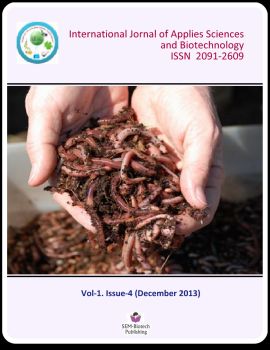Leakage of Phosphatases and Fertility of Buck Semen Cryopreserved under Different Freezing Modes
DOI:
https://doi.org/10.3126/ijasbt.v1i4.8913Keywords:
Buck Semen, Freezing rates, Seminal Plasma phosphatases, Semen Cryopreservation, ACP, AKPAbstract
Present study was conducted on 160 ejaculates collected at weekly interval by artificial vagina method from 13 adult Sirohi bucks. Pooled ejaculates were diluted with Tris-egg yolk-citric acid-fructose-glycerol extender (1:4), filled and sealed in straws. Few straws of diluted semen were thawed (40° C/15 seconds) and assessed for acid and alkaline phosphatases (ACP and AKP) in seminal plasma of diluted semen (Control Group). Remaining semen straws were randomly grouped to constitute freezing mode groups (M1, M2, M2, and M4) and processed further for cryo-preservation of semen. Accordingly diluted semen straws were cooled @-4° C/minute from 25° C up to 5° C thereafter equilibrated for 2 hours and frozen up to -160° C @ 15, 20, 25 and 300 C/minute for M1, M2, M3 and M4 groups respectively. These frozen straws were hold at this temperature for 2 minutes then stored separately in LN2. After 7 days of storage, straws from each freezing mode group were thawed and assessed for ACP and AKP in seminal plasma. In vivo fertility trials were also conducted with straws of control (fresh diluted semen) as well as freezing mode groups (frozen at different freezing rates). Least square analysis of variance for the data obtained revealed highly significant (P ≤ 0.01) rise in the seminal plasma ACP and AKP enzyme levels in frozen thawed semen as compared to that in fresh diluted semen. The Values of ACP and AKP also differed significantly (P ≤ 0.05) among all the freezing mode groups wherein lowest values of ACP were observed in M3 group followed by M4, M2 and M1 groups in increasing order whereas, lowest values of AKP were observed in M3 followed by M2, M4 and M1 groups in increasing order. Highest fertility rates were observed with semen from M3 followed by M2, M4 and M1 groups. On the basis of enzyme leakage and in-vivo fertility trials, the optimum freezing rate for cryopreservation protocol was arrived at 25° C/minute.
DOI: http://dx.doi.org/10.3126/ijasbt.v1i4.8913
Int J Appl Sci Biotechnol, Vol. 1(4): 202-207




